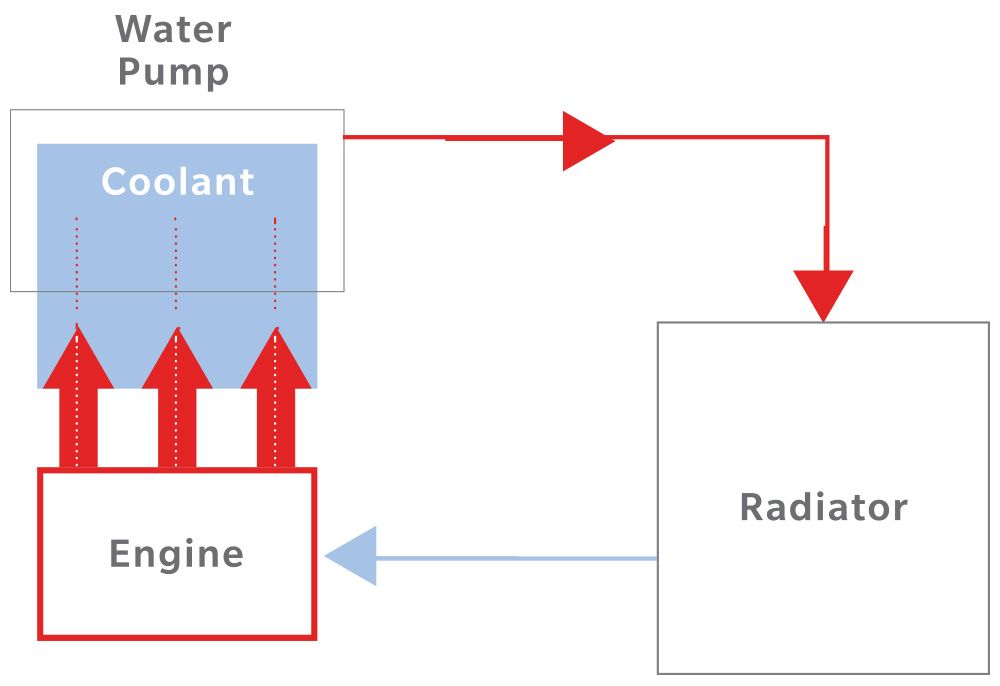Steve Schreck and Drew Conkling know why excessive heat can ruin an engine — and a road trip. As product managers at a major international auto parts manufacturer, their job is to oversee the development of cooling system components that go into millions of vehicles worldwide. Here, they provide tips on what to do when your car overheats and suggest basic car maintenance that can help prevent your car from overheating.
Your car is overheating. Now what?
Most cars are equipped with warning lights and a pressure relief valve, so if your engine starts to overheat, you'll probably get advance warning before it damages the engine. But don't keep driving. Important steps to follow when the warning light flashes are:
- Pull over.
- Turn off your engine.
- Call for help.
That's it — stop there. "Don't even think about touching the radiator cap while you're waiting for a tow truck," Schreck says. "The cooling system is highly pressurized. Just loosening the cap a little can set off a geyser of hot coolant."
"Also, there's nothing you can do from the side of the road," says Conkling. "Your car needs to be towed to a professional."
If towing to an auto shop is not an option and you have no choice but to take matters into your own hands, consider following these steps:
Wait until the engine completely cools — at least 30 minutes.
You might be able to speed up the cooling process if you can pop the hood with a latch located inside the car cabin. But, do not touch or attempt to open the hood until the engine is completely cool.
Check the coolant/antifreeze reservoir.
Typically, this reservoir is a translucent plastic tank near the radiator. If it's empty or low on fluid, and you've allowed time for the engine to cool, refill the tank with new antifreeze.
Check hoses for leaks or blockage.
Chances are, if the coolant tank is completely empty or you spot a drip or puddle on the ground, you've got a leak.
This is why you need to know how your engine's cooling system works
Technically, here's what's happening: Heat from your engine is absorbed by coolant (think: antifreeze), which the engine's water pump pushes to the radiator, where it cools and is recirculated back to the engine.

Coolant lowers the freezing point of water, increases its boiling point and can help prevent corrosion.

The simple answer? "Think of the water pump as a human heart sending blood throughout the body — it keeps pumping coolant through the engine, then back again," says Schreck. Although engines no longer use water for cooling, the term water pump is still used to describe the system that moves coolant through an engine.
The coolant — the fluid that flows through the cooling system — flows from the engine to the radiator, where heat gets released into the atmosphere. "That's why the technical name for the radiator is the heat exchanger. It takes the heat out of the coolant," says Conkling. "The coolant then flows back to the engine to grab more heat. It's a continuous loop."
This is what happens when it doesn't work
When something goes wrong in the cooling system, all components in the engine run at a temperature that's too high, Conkling says. "The engine and coolant heat up, and metal keeps expanding the hotter it gets." Parts of the engine can warp or melt, resulting in costly repairs. Depending on the damage, you may even need a new engine.
Hot weather and blasting the AC aren't causing the car to overheat
Conkling puts it this way: If you were speeding through Death Valley in 1973 with the AC blasting, turning it off and slowing your speed might help cool the engine. But modern cars are typically better designed to handle that kind of load, so when your instruments say the car is overheating, the cooling system may be malfunctioning. "No amount of letting it cool off in the shade is going to solve the problem."
Chances are, you need a mechanic to tell you why the car is overheating
Why? Schreck explains, by way of a breakdown he experienced. "I had a 2005 car that started blowing coolant all over the road," he recalls. "My mechanic ran a diagnostic test and found the issue was a small defect in the radiator cap. You're not going to pinpoint something like that without testing on sophisticated equipment." Three common reasons a car overheats:
Thermostat failure
The cooling system's thermostat works like a heat-sensitive valve. When you start a car, coolant circulates in the engine until it reaches a certain temperature, then the thermostat opens the flow of coolant to the radiator, where heat is released. If the thermostat fails to open, the coolant circulates in the engine and gets hotter, which can lead to overheating.
Blocked airflow
As you drive, air is constantly forced through the radiator. This airflow is what removes heat from the coolant and sends it into the atmosphere. Any buildup of material on the front or back side of the radiator (think: leaves, bugs, road debris, snow) can obstruct the flow of air.
Leaking water pump
Over time, coolant gets dirty and deteriorates, and rust and scale can build up in the fluid. This buildup degrades the seals in the pump and can be a common source of coolant leaks.
Pro tips to help prevent a car from overheating
Schreck and Conkling offer this advice for preventing a costly meltdown.
- Coolant picks up dirt and particles that decrease its effectiveness. Coolant that looks cloudy or rusty needs to be replaced. Check the appearance of coolant at every oil change.
- Regardless of how coolant looks, it should be replaced as often as recommended by the manufacturer of your car, typically every two to five years. (See your owner's manual.)
- Use the type of coolant specified by the manufacturer — as in chemical type, not merely brand. Each type contains a different blend of corrosion inhibitors; using the wrong one can damage your cooling system.
- When in doubt, take your car to a professional. Full-service repair shops have access to the latest manufacturer recommendations and have all types of coolant on hand.

The simple answer? "Think of the water pump as a human heart sending blood throughout the body — it keeps pumping coolant through the engine, then back again," says Schreck. Although engines no longer use water for cooling, the term water pump is still used to describe the system that moves coolant through an engine.
The coolant — the fluid that flows through the cooling system — flows from the engine to the radiator, where heat gets released into the atmosphere. "That's why the technical name for the radiator is the heat exchanger. It takes the heat out of the coolant," says Conkling. "The coolant then flows back to the engine to grab more heat. It's a continuous loop."
This is what happens when it doesn't work
When something goes wrong in the cooling system, all components in the engine run at a temperature that's too high, Conkling says. "The engine and coolant heat up, and metal keeps expanding the hotter it gets." Parts of the engine can warp or melt, resulting in costly repairs. Depending on the damage, you may even need a new engine.
Hot weather and blasting the AC aren't causing the car to overheat
Conkling puts it this way: If you were speeding through Death Valley in 1973 with the AC blasting, turning it off and slowing your speed might help cool the engine. But modern cars are typically better designed to handle that kind of load, so when your instruments say the car is overheating, the cooling system may be malfunctioning. "No amount of letting it cool off in the shade is going to solve the problem."
Chances are, you need a mechanic to tell you why the car is overheating
Why? Schreck explains, by way of a breakdown he experienced. "I had a 2005 car that started blowing coolant all over the road," he recalls. "My mechanic ran a diagnostic test and found the issue was a small defect in the radiator cap. You're not going to pinpoint something like that without testing on sophisticated equipment." Three common reasons a car overheats:
Thermostat failure
The cooling system's thermostat works like a heat-sensitive valve. When you start a car, coolant circulates in the engine until it reaches a certain temperature, then the thermostat opens the flow of coolant to the radiator, where heat is released. If the thermostat fails to open, the coolant circulates in the engine and gets hotter, which can lead to overheating.
Blocked airflow
As you drive, air is constantly forced through the radiator. This airflow is what removes heat from the coolant and sends it into the atmosphere. Any buildup of material on the front or back side of the radiator (think: leaves, bugs, road debris, snow) can obstruct the flow of air.
Leaking water pump
Over time, coolant gets dirty and deteriorates, and rust and scale can build up in the fluid. This buildup degrades the seals in the pump and can be a common source of coolant leaks.
Pro tips to help prevent a car from overheating
Schreck and Conkling offer this advice for preventing a costly meltdown.
- Coolant picks up dirt and particles that decrease its effectiveness. Coolant that looks cloudy or rusty needs to be replaced. Check the appearance of coolant at every oil change.
- Regardless of how coolant looks, it should be replaced as often as recommended by the manufacturer of your car, typically every two to five years. (See your owner's manual.)
- Use the type of coolant specified by the manufacturer — as in chemical type, not merely brand. Each type contains a different blend of corrosion inhibitors; using the wrong one can damage your cooling system.
- When in doubt, take your car to a professional. Full-service repair shops have access to the latest manufacturer recommendations and have all types of coolant on hand.
Written by
The information contained in this page is provided for general informational purposes only. The information is provided by Farmers® and while we endeavor to keep the information up to date and correct, we make no representations or warranties of any kind, express or implied, about the completeness, accuracy, reliability, suitability or availability with respect to this article or the information, products, services or related graphics, if any, contained in this article for any purpose. The information is not meant as professional or expert advice, and any reliance you place on such information is therefore strictly at your own risk.
Related articles



